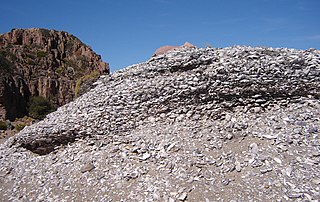
A midden is an old dump for domestic waste which may consist of animal bone, human excrement, botanical material, mollusc shells, potsherds, lithics, and other artifacts and ecofacts associated with past human occupation.

In the classification of the archaeological cultures of North America, the Archaic period in North America, taken to last from around 8000 to 1000 BC in the sequence of North American pre-Columbian cultural stages, is a period defined by the archaic stage of cultural development. The Archaic stage is characterized by subsistence economies supported through the exploitation of nuts, seeds, and shellfish. As its ending is defined by the adoption of sedentary farming, this date can vary significantly across the Americas.
Fig Island, also known as 38CH42, is an archaeological site on the Atlantic Coast of South Carolina, consisting of three shell rings. Shell rings are curved shell middens wholly or partially surrounding a clear central area or plaza. The site includes one of the largest and most complex shell rings in North America, and one of the best preserved circular shell rings.
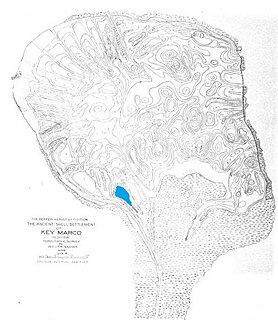
Key Marco was an archaeological site (8CR48) consisting of a large shell works island next to Marco Island, Florida. A small pond on Key Marco, now known as the "Court of the Pile Dwellers" (8CR49), was excavated in 1896 by the Smithsonian Institution's Pepper-Hearst Expedition, led by Frank Hamilton Cushing. Cushing recovered more than 1,000 wooden artifacts from the pond, the largest number of wooden artifacts from any prehistoric archaeological site in the eastern United States. These artifacts are described as some of the finest prehistoric Native American art in North America. The Key Marco materials are principally divided between the University of Pennsylvania Museum of Archaeology and Anthropology, University of Pennsylvania; the Department of Anthropology, National Museum of Natural History, Smithsonian Institution; and the Florida Museum of Natural History, University of Florida. The original pond was completely excavated and refilled. It is now covered by a housing subdivision. Excavations of small parts of the site were also conducted in 1965 and 1995.

Horr's Island is a significant Archaic period archaeological site located on an island in Southwest Florida formerly known as Horr's Island. Horr's Island is on the south side of Marco Island in Collier County, Florida. The site includes four mounds and a shell ring. It has one of the oldest known mound burials in the eastern United States, dating to about 3400 radiocarbon years Before Present (BP). One of the mounds has been dated to as early as 6700 BP. It was the largest known community in the southeastern United States to have been permanently occupied during the Archaic period.
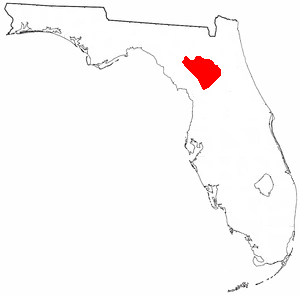
The Cades Pond culture is defined as a Middle Woodland Southeast period archaeological culture in north-central Florida, dating from around 100 to 600 CE.
Dismal Key is a small island, part of the Ten Thousand Islands archipelago in the Gulf of Mexico off the coast of Florida. The island is artificial, constructed by people of the Glades culture. Construction of the island proceeded in stages over some 1,500 years following the end of the Archaic period in Florida. Occupation probably ended a couple of centuries before the arrival of Europeans in Florida. Dismal Key was occupied by several hermits in the 20th century.

The St. Johns culture was an archaeological culture in northeastern Florida, USA that lasted from about 500 BCE until shortly after European contact in the 17th century. The St. Johns culture was present along the St. Johns River and its tributaries (including the Oklawaha River, and along the Atlantic coast of Florida from the mouth of the St. Johns River south to a point east of the head of the St. Johns River, near present-day Cocoa Beach, Florida. At the time of first European contact, the St. Johns culture area was inhabited by speakers of the Mocama, Agua Fresca and Acuera dialects of the Timucua language and by the Mayacas.

The Deptford culture was an archaeological culture in southeastern North America characterized by the appearance of elaborate ceremonial complexes, increasing social and political complexity, mound burial, permanent settlements, population growth, and an increasing reliance on cultigens.
The Tchefuncte site (16ST1) is an archaeological site that is a type site for the prehistoric Tchefuncte culture period. The name is pronounced Che-funk'tuh. It is located in the southeast section of Fontainebleau State Park near Mandeville, St. Tammany Parish, Louisiana.
The Mount Taylor period or Mount Taylor culture was a pre-ceramic archaeological culture in northeastern Florida in the middle to late Archaic period. The Mount Taylor period lasted from approximately 5000 or 4000 BCE to 2000 BCE. Most archaeological sites associated with the culture are in the middle and upper parts of the St. Johns River valley, with related sites occurring along the east coast of Florida, and at a few other places in Florida. The Mount Taylor culture emerged from the regionally undifferentiated middle Archaic culture in Florida, and was succeeded by the late Archaic Orange period.

The Tagoyano Shell Midden is an archaeological site in what is now the city of Tsugaru, Aomori Prefecture, in the Tōhoku region of northern Japan with an early Jōmon period shell midden. The site was designated a National Historic Site in 1944 by the Japanese government. It is a rare example of a shell midden to be found near the coast of the Sea of Japan.
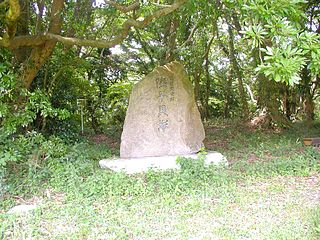
The Okadaira Shell Midden is an archaeological site in the Iide area of the village of Miho, Ibaraki Prefecture, in the northern Kantō region of Japan containing a late Jōmon period shell midden. The site was designated a National Historic Site of Japan in 1998.
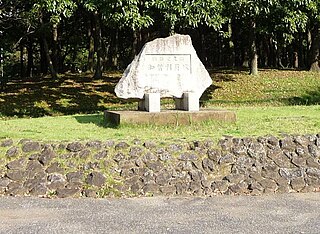
The Kasori Shell Mounds is an archaeological site in the Sakuragi neighborhood of Wakaba ward of the city of Chiba, Chiba Prefecture, in the Kantō region of Japan. It contains the largest known shell midden found in Japan, and was designated a National Historic Site of Japan in 1971. Its status was raised to that of a special National Historic Site in 2017
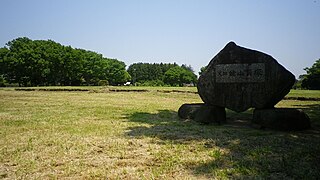
The Ubayama Shell Midden is an archaeological site in the Kashiwai neighborhood of the city of Ichikawa, Chiba Prefecture, in the Kantō region of Japan containing a middle to late Jōmon period shell midden. The midden was designated a National Historic Site of Japan in 1967.
The Soya Shell Midden is an archaeological site in the Soya neighborhood of the city of Ichikawa, Chiba Prefecture, in the Kantō region of Japan containing a Jōmon period shell midden and settlement ruin. It was designated a National Historic Site of Japan in 1979. The shell mound was formed in the latter half of the Jōmon period, about 4000 to 3000 years ago.
The Tsukinoki Shell Midden is an archaeological site in the Ninomachi neighborhood of Chūō ward of the city of Chiba, Chiba Prefecture, in the Kantō region of Japan containing a Jōmon period shell midden and settlement ruin. The site was designated a National Historic Site of Japan in 1978, with the area under protection extended in 2002 and again in 2006
The Hanawa Shell Midden is an archaeological site in the Kasori neighborhood of Wakaba ward of the city of Ichikawa, Chiba Prefecture, in the Kantō region of Japan containing a Jōmon period shell midden and settlement ruin. The midden was designated a National Historic Site of Japan in 2006.

The Horinouchi Shell Midden is an archaeological site in the Horinouchi neighborhood of the city of Ichikawa, Chiba Prefecture, in the Kantō region of Japan containing a Jōmon period shell midden and settlement ruin. The site was designated a National Historic Site of Japan in 1964, with the area under designation expanded in 1967 and again in 1972.












